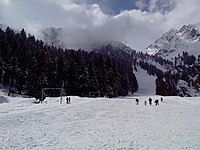Naltar Valley
This article has multiple issues. Please help improve it or discuss these issues on the talk page. (Learn how and when to remove these messages)
|
Naltar Valley
وادی نلتر | |
|---|---|
|
Top left to right: A bridge in Naltar Valley, Grazing yalks in Naltar Valley, Naltar Lakes, Naltar ski resort | |
| Country | |
| Adm. Unit | Gilgit−Baltistan |
| District | Gilgit District |
| Tehsil | Gilgit Tehsil |
| Time zone | UTC+05:00 (PKT) |

Naltar (Template:Lang-ur) is a valley situated near the city of Gilgit in Gilgit−Baltistan, Pakistan. Naltar is about 34 kilometres (21 mi) from Gilgit[1].[2][3] Naltar is a forested region known for its dramatic mountain scenery. Naltar valley is also famous for the three lakes i.e., are Strangi lake, Blue lake and Bodlok lake. There is also a natural lush green garden known as "Halima garden".[citation needed]

Ski competitions are held at Naltar ski resort. Naltar Bala (upper) and Naltar Paain(lower) are two villages of Naltar valley. Naltar Paain is at a distance of 34 kilometres (21 mi) and Naltar Bala at 40 kilometres (25 mi) from Gilgit. Naltar Expressway connects Naltar with Gilgit City via Nomal and Faizabad. There is a town known as Nomal between Naltar valley and Gilgit. A road from Nomal goes to 'The Silk Route' to China.[citation needed]
Naltar Hydropower Projects (I, II, IV)
Recently the government has constructed an 18 MW hydropower plant, Naltar Hydropower Plant-IV (operational since October 2007), near Naltar Pine, in addition to three smaller hydel power generating plants (Naltar I, II, IV of 3.02 MW combined) already there, to fulfill the power requirement of the area as well as Gilgit. Naltar-III and Naltar-V Hydropower Projects of 16 MW and 14 MW generation capacity respectively are under construction.[4]
[[File:En Route Naltar. scene.jpg|thumb|Naltar is a valley near Gilgit, Hunza and Nomal
Naltar Wildlife Sanctuary
The Naltar Wildlife Sanctuary is a protected area in the valley that was established on 22 November 1975.[5]
Flora & Fauna
The sanctuary is forested, there being a greatly comfortable growth of mixed montane, broadleaf and coniferous forests at lower altitudes and montane coniferous forest higher up. Coniferous species that are present include Picea and Juniperus. The trees present include Fraxinus, Olea, Pistacia, Sageretia, Betula, Salix, Populus and Krascheninnikovia ceratoides. Some herbs that grow here and there include Artemisia, Haloxylon and Stipa.
A few number of Astor markhor and an endangered specie of wild goat lives in the reserve. Other large mammals present include the Alpine ibex, snow leopard, brown bear, grey wolf, red fox, beech marten and leopard cat. Almost 35 species of birds have been recorded in the valley, including Brooks's leaf warbler.[2]
There are five[citation needed] lakes in the Naltar valley known as 'Satrangi Lake' Halima Lake' Bodo Lake'Green Lake' &'Blue Lakes' at a distance of 13 kilometers (8 mi) from Naltar Bala. The road from village to the lakes is nonmetallic and narrow alongside a stream throughout this road coming from the mountains. In winter it is almost impossible to reach the lake through any vehicle due to the snow (10 to 15 feet high) on the road.[6]
Tourism Facilities
The valley offers a variety of flora, fauna as well as natural scenery. Government has established a number of rest houses in the valley. GBPWD Rest house is the oldest rest house in the valley. FCNA, GB Scouts & PAF had their own rest houses to serve the purpose. There are also a number of private accommodation facilities & hotels in the valley.
People
- Muhammad Abbas - Participant of Vancouver Olympic
- Amina Wali- South Asian Winter Games Silver medalist
- Ifrah Wali - South Asian Winter Games gold medalist
See also
References
- ^ "Naltar Valley on Maps". Google Maps. Retrieved 25 August 2019.
- ^ a b "Naltar Valley in Gilgit-Baltistan". sco.gov.pk. Special Communications Organization. Retrieved 24 August 2019.
- ^ "Naltar Valley". www.ali.net.pk. Retrieved 2 June 2018.
- ^ "Hydropower Resources in Gilgit-Baltistan". Hydro Power Resources of Pakistan (PDF). Private Power and Infrastructure Board. February 2011. pp. 63, 66, 71–73. Retrieved 25 August 2019.
- ^ Green, Michael John Beverley (1990). IUCN Directory of South Asian Protected Areas. IUCN. p. 159. ISBN 978-2-8317-0030-4.
- ^ "Naltar Lakes". www.travelinpakistan.com. Retrieved 2 June 2018.
External links




